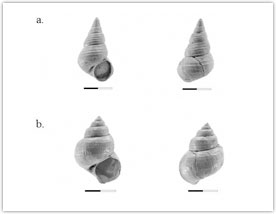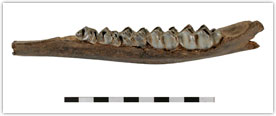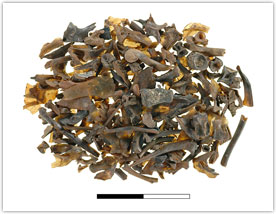|
|
|||||||||
Molluscs: The study of 37 sediment samples resulted in the examination of over 60,000 specimens. Their analyses yielded ca. 70 species from 28 genera and 20 families. Among these, ca. 50% of the species and ca. 15% of the families are extinct. Examining the distribution of molluscs throughout the GBY sequence suggests that the most abundant genera are Valvata, Melanopsis and Theodoxus. The most abundant family is the Planorbidae, represented by species of shallow, vegetated or muddy aquatic habitats. The 37 examined samples are very diverse and differ between layers both in number of species (0-43) and in specimen richness (0-8,200).
Fish: The fossil fish fauna of GBY is rich, comprising many taxa of Eurasian and African origin. Of the 21 native species currently living in the Jordan Rift Valley, 13 species were identified at GBY: nine species of the family Cyprinidae, two species of the family Cichlidae and a single species of Clariidae. Of the identified species, four are endemic to the Jordan Rift Valley and Lake Kinneret (A. lissneri, B. longiceps, C. damascina, A. flavijosephi) and one is endemic to Lake Hula (M. hulensis). The relative abundance of these families differs along the GBY sequence. The habitat of most fish species is slow-moving water or streams. The variability in body size (length), especially in comparison with the largest species, Clarias sp., indicates a rich environment where numerous species could feed in the same habitat.
Mammals: A large variety of mammalian taxa is represented in the GBY faunal assemblages, exhibiting a mixture of African (e.g., bovids, equids, hippopotamus) and Euro-Asian (e.g., cervids, Ursus, Sus, Vulpes) origins. Identification of grassland mammalian species (e.g., equids and some bovids) as well as woodland species (e.g., elephant, cervids and other bovids) points to the existence of habitats of both types. It thus seems that the presence of a permanent water body at GBY, clearly an ecological focal point, served as a preferred habitat not only for hippopotamus but also for most of the biomass in the vicinity of the site.
Micromammal analyses at GBY resulted in the identification of a variety of habitats, including meadows, watery plains and riverbanks (typical of Microtus guentheri, the most common species through the GBY sequence), grassland, scrub country, open habitats, marshes, deciduous forest, and Mediterranean woods. |
|||||||||
Copyright ©,2009 , The Hebrew University of Jerusalem. All Rights Reserved. Contact Administrator


